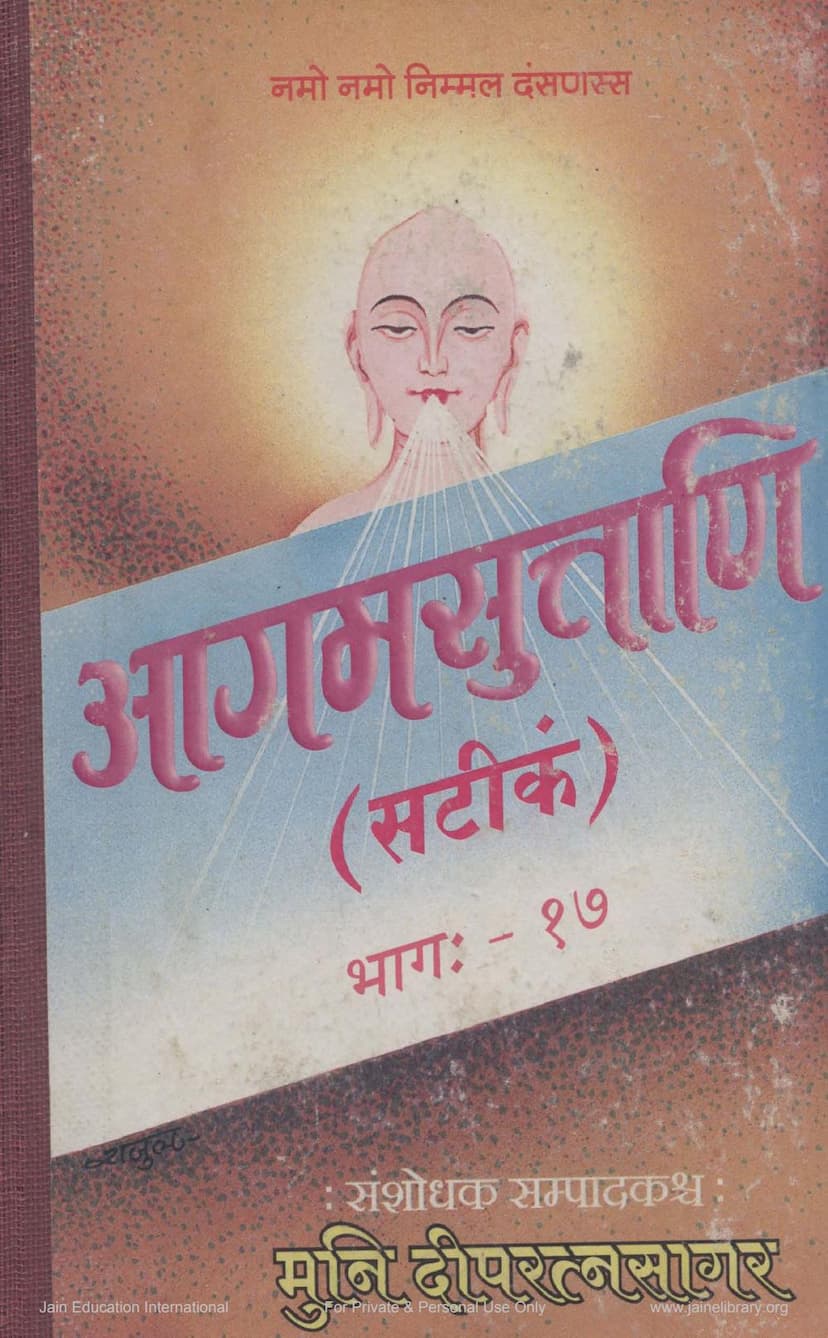Agam Suttani Satikam Part 17 Nishitha
Added to library: September 1, 2025

Summary
Here's a comprehensive summary of the provided Jain text, "Agam Suttani Satikam Part 17 Nishitha," focusing on the content of its 19th and 20th chapters (Uddeshaka 19 & 20) based on the provided snippets:
This volume, part 17 of the Agam Suttani Satikam series, titled "Nishitha," specifically covers the 19th and 20th chapters (Uddeshaka 19 and 20) of the Nishitha Sutra, a fundamental text in Jainism. The work is compiled and annotated by Muni Dippratnasagar.
Overview of Content:
The Nishitha Sutra, particularly this portion, delves into the detailed rules and regulations (Vidhi-Nishedha) governing the conduct of Jain monks and nuns. The focus is on the permissible and prohibited actions related to various aspects of their ascetic life, with a strong emphasis on penance (prayaschitta) for transgressions.
Key Themes and Topics Covered in the Provided Snippets (Primarily Uddeshaka 19 & 20):
The text meticulously outlines disciplinary actions and atonements for a wide range of situations encountered by ascetics. Based on the provided pages, the summary can be structured around the following major themes:
1. Prohibitions and Permissible Actions (Vidhi-Nishedha):
- Interactions with the Outside World: A significant portion of the text addresses the strictures surrounding interactions with laypeople (grihasthas) and non-Jains (anyatirthikas). This includes prohibitions on accepting things from them, engaging in certain types of conversations, and entering specific types of dwellings or spaces. The text details the specific penalties for violating these rules.
- Food and Drink (Ashanadi and Panadi): The text elaborates on the rules concerning the consumption of food and drink, including prohibitions on accepting certain types of food (e.g., impure, offered at specific times or places, prepared with prohibited methods), and engaging in activities like eating with non-ascetics.
- Clothing and Possessions (Vastra and Upadhi): Rules regarding the types of clothing, their use, and the possession of other material items are discussed. This includes prohibitions on carrying extra clothes, wearing or using items made from prohibited materials, or engaging in activities associated with adornment or luxury.
- Movement and Dwelling (Gaman and Vasati): The text outlines restrictions on travel, such as prohibitions on entering certain types of dwellings or areas, traveling at specific times, or engaging in activities related to vehicles like boats. It also covers rules about where and how ascetics can reside.
- Daily Conduct and Practices: Specific prohibitions related to daily practices are mentioned, such as rules about recitation of scriptures (svadhyaya), engaging in conversation with specific individuals, and the proper conduct during different times of the day (sandhya).
2. Penance and Atonement (Prayaschitta):
- Classification of Offenses: The text appears to categorize offenses based on their severity, with different forms of penance prescribed for each. The recurring mention of "chulahu" (minor penance), "masia" (monthly penance), and "chauguru" (penance for four groups/levels of offense) suggests a graduated system of atonement.
- Specific Transgressions and Their Penances: The detailed listing of various prohibited actions implies a corresponding penance for each. These range from minor infractions to more serious ones, all requiring prescribed forms of atonement to purify the ascetic's conduct. The text often specifies the duration or type of penance based on the nature of the offense, the ascetic's status (e.g., novice vs. ordained), and the intent behind the action.
3. Ascetic Purity and Discipline:
- Maintaining Purity: A central theme is the unwavering commitment to maintaining spiritual purity (nishitha). This involves meticulous attention to every aspect of conduct, from how food is accepted and consumed to how interactions with the world are managed.
- Consequences of Transgression: The text emphasizes that transgressions, even seemingly minor ones, carry spiritual consequences, leading to the need for penance. This underscores the importance of mindfulness and adherence to the monastic code.
- Guidance for Monks and Nuns: The sutras provide detailed guidelines for ascetics to navigate complex situations and avoid spiritual pitfalls, ensuring the integrity of their spiritual path.
4. Specific Examples and Scenarios:
The text uses numerous specific examples to illustrate the rules. While the provided snippets don't detail every single one, the categories mentioned (e.g., interactions with royalty, ascetics of different persuasions, use of specific objects like vessels, and rituals like sandhya) give a glimpse into the practical scenarios addressed. The numerous references to "Grahya," "Agrahya," "Vidhi," "Nishedha," and "Prayaschitta" highlight the rule-based structure of monastic life.
In essence, the 19th and 20th chapters of the Nishitha Sutra, as presented in this volume, serve as a vital manual for Jain ascetics, meticulously detailing the boundaries of their conduct and the methods for spiritual purification through penance. The granular level of detail underscores the profound emphasis on discipline and ethical living within Jain monasticism.